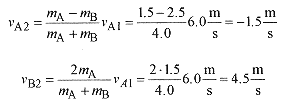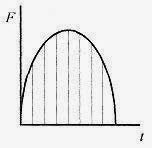Collision and Impulse
Momentum provides a new analysis technique. With force analysis and work energy analysis, application of the appropriate analysis technique to “the problems at the end of the chapter” was reasonably straight forward. At the end of the chapter on forces use force analysis. At the end of the chapter on work energy use work energy analysis. However, at the end of the chapter on momentum we need to use momentum and work energy analysis. Knowing when to use work energy analysis and when to sue momentum analysis adds a whole new dimension to problem solving.
As will become evident in this chapter, there are certain types of collision problems where conservation of momentum and conservation of energy can be applied and certain problems where only conservation of momentum can be applied. This is no where better illustrated than in the ballistic pendulum problem (presented later), where conservation of momentum is applied in one part of the problem and conservation of energy in another part of the problem. Learning where to apply these two conservation laws is difficult. As the problems in this chapter are presented, be aware of which law is being applied and why.
Before doing problems take a general look at collisions in one dimension. Throughout the discussion A and B will designate the two particles, and 1 and 2 will designate before and after the collision.
There are two types of collisions:
In elastic collisions both momentum and energy are conserved. Examples of elastic collisions are billiard balls or any collision where the participants bounce.
In inelastic collisions only momentum is conserved. Examples of inelastic collisions are railroad cars coupling or a steel ball thrown into a piece of clay or any collision where the participants stick together.
It is this sticking or nonsticking that determines if energy is conserved or not. When we say that energy is not conserved in a collision where the participants stick together, we mean only that mechanical energy, (1/2)mv2, is not conserved.
Inelastic Collisions.
Consider first inelastic collisions. Where the particles stick together. Using the notation described above
This equation states that after the collision, the velocity of the A particle is the same as the velocity of the B particle. Applying in the law of conservation of momentum and this condition
The left side of the equation is the momentum before collision, and the right side is the momentum of the two masses stuck together traveling at the same velocity after the collision.
Take the special case where the B particle is initially stationary. While mechanical energy is not conserved in the collision the kinetic energies can be written as
and
K2 can be rewritten using the conservation of momentum statement
Comparing these two equations gives a relationship for the energy before and after collision.
A ballistic pendulum, a device for measuring the speed of a bullet, consists of a block of wood suspended by cord. When the bullet is fired into the block, the block is free to rise. How high does a 5.0kg block rise when a 12g bullet traveling at 350m/s is fired into it?
Solution: This is a most interesting and instructive problem. The collision between the bullet and the block is clearly inelastic (the bullet comes to rest in the block). Part of the kinetic energy of the bullet Goesinto friction as the bullet burrows its way into the block. Therefore mechanical energy is not conserved.
Because the collision is inelastic, apply conservation of momentum of the collision. Before the collision, all the momentum is in the mv of the bullet. After the collision, the momentum is in the (m+M)V of the block and bullet. We assume that the bullet comes to rest (transfer all its momentum) before there is appreciable motion of the bullet block combination.
After the collision, the rise of the block is determined by energy analysis. The kinetic energy of the block Goesinto potential energy.
or
Substituting for V from mv = (m+M)V
so
or
giving the relation between the velocity of the bullet and the height the block and bullet rise. For this problem
In this problem the 0.012 can be neglected in comparison to 5.0. This is not always the case so we write m + M as 5.012 as a reminder to include both m +M in the calculation.
<><><><><><><><><><><><>
A 6.0g bullet is fired horizontally into a 2.8kg block resting on a horizontal surface with coefficient of friction 0.30. The bullet comes to rest in the block, and the block slides 0.65m before coming to a stop. What is the velocity of the bullet?
Solution:
Assume the bullet comes to rest in the block before the block moves appreciably and that all the momentum in the bullet is transferred to the bullet block combination.
Once the bullet block combination is moving at V, the kinetic energy, (1/2)(m+M)V2, Goesinto work to overcome friction ì(m + M)gx
Substituting
or
Elastic Collisions
Now look at elastic collisions, where the particles bounce. In elastic collisions no energy is lost to permanent deformation of the particles. Write a conservation of momentum statement for the collision diagrammed in Fig. 10 5.
Now write a conservation of energy statement.
These two statements can be written as
and
Now divide the (rewritten) conservation of energy statement by the conservation of momentum statement to find
or
The term vA1 – vB1 is the speed of approach, the speed of A relative to B measured by an observer on B. The term vA2 – vA2 is the speed of departure. So in an elastic collision the speed of approach is equal to the speed of departure.
Now find expressions for the velocities after the collision in terms of the masses and the velocities before the collision. From the velocity statement (above)
From the conservation of momentum statement (above), substitute the equation for vB2.
and with a little algebra
With these two statements vA2 and then vB2 can be predicated from the initial masses and velocities.
Look at some special cases:
If mA = mB, the masses are equal then vA2 = vB1 and vB2 = vA1
The particles exchange velocities. This is what happens in billiards!
If vB1 = 0, the struck mass is at rest, then
For some realistic cases where the masses are equal or one particle is at rest the resulting expressions for the velocities are easily calculated.
A 1.5kg block traveling at 6.0m/s strikes a 2.5kg block at rest. After an elastic collision, what are the velocities of the blocks?
Solution: This is the special case where the struck block is at rest so
the striking block rebounds at ( ) 1.5m/s, and the struck block moves off at 4.5m/s.
<><><><><><><><><><><><>
A 1.0kg steel ball is attached to a light weight 1.0m long rod pivoted at the other end. The ball is released at the horizontal and strikes a 3.0kg steel block resting on a surface with coefficient of friction 0.25. How far does the block travel?
Solution: This problem is similar to the ballistic pendulum problem in that conservation of energy and conservation of momentum and then work energy have to be applied correctly. From the description of the collision assume that it is elastic.
First calculate the velocity of the ball as it hits the block. Potential energy Goesinto kinetic energy.
The collision is elastic and vB1 = 0, so
The gives the initial velocity of the struck block. The kinetic energy Goesinto work against friction.
Go back over this problem and see where energy analysis is applied, conservation of momentum is applied, and work energy analysis applied. Knowing what laws to apply where in the problems is the hard part of collision problems.
Impulse
Impulse is the name given to a force that acts for a very short period of time. A struck baseball, golf ball, or tennis ball are examples of impulses or impulse forces. In most impulses, it is impossible to graph force versus time; though we can often estimate how the force varies with time.
Force is defined terms of change in momentum as ![]()
If the force is time dependent, F(t), then rewriting, Δ(mv) = F (t) Δt
With calculus notation this statement would be written as![]()
The left side is the change in momentum, and the right side is the area under the F(t) versus t curve. This integral is called the impulse or impulse integral. If the curve of F(t) versus t were a parabola (reasonable for an impulse), then the right side of the equation would be the area under the curve in Fig. 10 7.
A 1.2kg croquet ball moving at 2.0m/s struck from behind by the impulse force shown in Fig. 10 8. What is the final velocity of the croquet ball?
Solution: The initial momentum is![]()
The impulse integral, the difference in momentum, can be calculated by inspection. The area under the curve (one half the base times the height) is


















